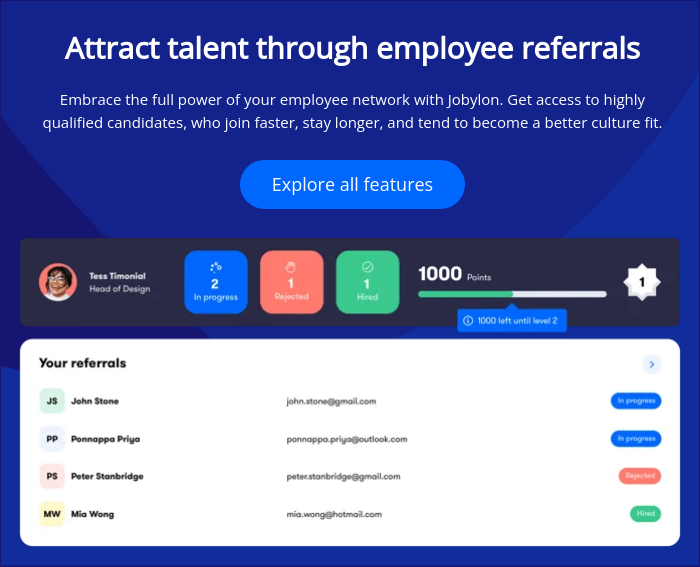With employer branding taking a central role in the talent acquisition process, more and more employers get hundreds of applications for each vacancy. However, if you’re looking to hire the best person for the job, you will also need a sharp assessment process. While there are a plethora of candidate evaluation tools available, selecting the ones that meet your requirements best can be confusing.
If you need to understand your options better, we have listed our favorite 13 assessment methods for you. Also, wherever possible we have put them in chronological order, so that you can see how everything fits together. Every employer and industry has different needs, so we don’t recommend adopting the below process in its entirety. However, we hope that it helps you create your best candidate evaluation process in a fast and easy way. Let’s get started.
1. Use an applicant tracking system
Applicant tracking systems (ATS) can make your recruitment process better, faster, and cheaper. ATS has become very popular with employers, so you may already be familiar with some of its functionalities, including providing information to prospective applicants, storing candidate applications, and facilitating internal and external communication. However, ATS can be a great assessment tool, too. Firstly, ATS may provide candidate evaluation functionality, such as automated resume screening or customized application forms. Also, they may integrate with other assessment tools, such as skills or aptitude tests or virtual interviewing software, offering a smooth candidate evaluation experience. No matter what assessments you require, we suggest starting with a strong ATS.
2. Create meaningful job ads
While they invest heavy budgets in candidate evaluation, employers sometimes miss the basics. Apart from employer screening, self-screening by applicants can also be an excellent opportunity to increase the quality of your candidate pool. So, when you think about candidate evaluation, start with your job ads. Instead of using generic, formulaic, and dry job ads, aim for specificity, relevancy, and uniqueness. Forget about corporate language and write in a way that reflects your brand and the style of your target candidates. Describe the duties and responsibilities of the job in a way reflective of the expected day-to-day routine. Lastly, be specific about which requirements are a must and which are a nice-to-have. It will enable candidates to self-screen for skill and cultural fit.
3. Ask the right knock-out questions
While lengthy application forms with demanding questions that require a long-form answer are a no-no, smart knock-out questions can be invaluable. Typically, these would be short and easy-to-answer questions to separate the wheat from the chaff for the role. For example, if you are hiring in Europe and you can’t sponsor candidates without a right to work in the EEA, checking whether applicants fulfill this criterion as part of your application process may be a good idea. We suggest incorporating a few knock-out questions per vacancy into your ATS application form based on your needs.
4. Screen resumes effectively
Resume screening has been a standard assessment process of every recruitment process for a long time. However, technology has enabled recruiters to assess resumes faster and better. AI-enabled solutions can use their algorithms to identify relevant skills, experience, and qualifications, making resume screening a breeze. However, we suggest blending technology with manual screening, as technology may not be at a place to make such decisions risk-free yet. For example, some AI solutions could lead to discrimination if used in the wrong way and without human intervention.
5. Use games to assess candidates
Who doesn’t like games, right? Gamifying the assessment process is a great idea because it allows you to acquire important information about your candidates while boosting the applicant experience. Nowadays, there are multiple gamification options available to select from. In our experience, games can be an excellent way for evaluating skills, especially technical ones like programming. You can implement gaming solutions as part of the initial application process or as part of the next assessment step depending on your needs and budget.
6. Consider psychometric tests
Psychometric tests are another interesting assessment option to consider. While they come at a cost for employers and may take some time to complete by candidates, they can provide valuable information about applicants. There are many types of tests to select from, however, numerical, verbal, and inductive reasoning may be the most common ones. We suggest using tests for specific roles, such as graduate recruitment programs, where evaluating based on experience may be hard.
7. Start with virtual interviews
In-person interviews can be helpful, however, they are time-consuming and may be cost-intensive for both employers and candidates. With this in mind, we suggest leveraging technology and shifting to virtual interviews. Using an HR interview to cover the basics before engaging the hiring manager is a common and sensible practice. However, instead of the classic phone screening, we suggest considering video, as it can enable richer communication. Also, you can implement asynchronous video interviewing, where applicants can answer questions in their own time in a more efficient manner.
8. Screen talent online
At this point of the process, you are likely to have some interesting candidates for the role in your pipeline. When you identify the few candidates you are planning to introduce to the hiring manager, I suggest using the power of search engines to review their public online information. Social media and other platforms have enabled everyone to build an online presence by engaging with or publishing their own content. This content can be an excellent source of information to know your candidates better and understands who is a better fit for the job. However, remember to stick to relevant information only.
9. Don’t forget in-person interviewing
In-person hiring manager interviews are the golden standard for candidate assessment for a good reason. While we suggest starting with alternative activities to keep costs down and gather useful information, inviting your top applicants for a one-to-one interview with the hiring manager is a must. We recommend adopting a semi-structured approach that includes some essential questions while allowing the conversation to flow as required. For best results, mix different types of questions, including general, competency, behavioral, personality, and technical ones.
10. Don’t forget to check references
Many employers check references transactionally, just to validate a candidate’s previous titles and employment dates. However, this may not be the optimal solution. In fact, references can be a great way to obtain reliable information about your applicant pool. While in some countries employers only provide limited information about their ex-employers, it’s always worth trying to get a detailed reference. Past employers may have interesting things to say about your candidates and you don’t want to lose the opportunity to have this information at your disposal.
11. Cover all bases with a background check
Background checks can be crucial, especially for sensitive roles such as accountants, secretaries, carers, or drivers, where relevant previous criminal activity may be a red flag. So, we suggest conducting a thorough background check to ensure everything is in order before making a hire. Of course, make sure you get a candidate’s consent and follow local legislation and best practice.
12. Start with a pilot project
Asking candidates for free work is a big no-no. However, paid projects can be an excellent way to pilot a working relationship. Depending on the role, this could be a one-day project or a contract that lasts for months. While this approach could be a turn-off for candidates looking for stability, most confident talent would welcome a pilot with the right terms, as ensuring a successful working relationship is a win-win. For best results, we suggest offering attractive terms and conditions to keep top talent happy.
13. Leverage the power of referrals
Referrals may be the safest way to hire. Candidates recommended by your people are typically a good fit not only for the job but also for the business. So, we suggest encouraging referrals and prioritizing this recruitment channel. Start by educating your people to identify relevant candidates. Then, set up a process for easy referrals. Last but not least, don’t forget to reward your employees for every successful referral.
Last thougts
In the fast-paced world of modern business, finding the right talent is an ever-evolving challenge, especially for larger organizations with complex needs. Assessment methods are like the compass guiding organizations through the vast sea of job applicants. They provide a structured and data-driven approach to hiring, ensuring that only the most qualified candidates make it through the selection process. This not only saves time but also helps in avoiding costly hiring mistakes.
Here's why assessment methods are a game-changer:
- Efficiency: With numerous job openings and hundreds of applicants, efficiency is key. Assessment methods streamline the hiring process, allowing HR teams to focus on candidates with the highest potential.
- Data-Driven Decisions: These methods rely on data and analytics to evaluate candidates objectively. This reduces bias in hiring and ensures that the best person for the job is selected, promoting diversity and inclusion.
- Quality Control: For larger organisations, maintaining consistent quality across hires is paramount. Assessment methods help in identifying the right skills and cultural fit, ensuring that each new employee contributes positively to the company culture and goals.
- Cost Savings: High employee turnover can be costly. By using effective assessment methods, organizations can hire candidates who are more likely to stay and grow with the company, saving on recruitment and training expenses.
- Competitive Advantage: Attracting top talent is crucial. Having a robust assessment process in place enhances the organization's reputation, making it an attractive destination for high-caliber candidates.
- Adaptability: As the business landscape changes rapidly, assessment methods can adapt to evolving job roles and requirements, ensuring that the organization remains agile and competitive.
In conclusion, assessment methods are the cornerstone of successful talent acquisition. Many organisations not only save time and resources but also enhance the overall quality of hires. In a world where talent is a precious commodity, these methods are the secret sauce that empowers large organizations to thrive and stay ahead of the curve.
Last updated:


